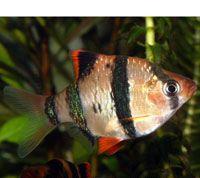Barb - Tiger
Scientific Name: Barbus tetrazona
Wed, 27th November, 2024 - 10:45 am GMT
Sponsor Ads:

Alternative Name
Scientific Name: Barbus tetrazonaBasic Info
The Tiger Barb is a relatively small fish. It will only reach a size of two to three inches at maturity. Tiger Barbs have vertical orange and black stripes on their bodies, which resemble tiger stripes. This is where their name originates. Males, however, will more of a redder than orange tint, especially in the nose and fin areas.
Health
Tiger Barbs do not require any special attention, and are rather hardy. They need their water to be between 68 and 78 degrees Fahrenheit. Tiger Barbs do best in slightly acidic water, with a pH in the range of six to seven. They like to eat live and frozen food, such as: blood worms, glass worms, brine shrimp, plankton, daphnia and vegetables. They will eat flake and freeze dried foods, as well. Breeding Tiger Barbs can be encouraged to breed by increasing water temperature to around 25 degrees Celsius. PH levels of 6.5 are best breeding tanks.Habitat
Fresh water fishBehavior
Tiger Barbs can add zest and life to any aquarium. This extremely active fish will keep an onlooker captivated for hours. They are especially pleasant when in schools of five or more. Tiger Barbs are also hardy, and easy to take care of, which makes them great for beginners, or a low maintenance tank. Don't let the name, Tiger Barb fool you. They are not a very aggressive fish. Tiger Barbs get their name from their body coloration. They can get a little aggressive if not kept in schools. They are highly active fish. Tiger Barbs might nip at other, less active fish, such as Angle Fish. Tiger Barbs enjoy plenty of space, and decorations such as driftwood and rocks. They may nibble on live plants.Origin
Southeast AsiaHistory
Tiger Barbs, or the Barbus tetrazona, are originally from Borneo, Indonesia.Common Foods
N/ASponsor Ads:
Imagination rules the world. --Napoleon Bonaparte
Barb - Tiger
Coded by: BGID® | ALL RIGHTS RESERVED Copyright © 2000-2024
Disclaimer | Privacy | Report Errors / Contact | Credits








 President of the United States of America - Real Estate mogul, Pageant owner and now one of the most controversial men in political history.
President of the United States of America - Real Estate mogul, Pageant owner and now one of the most controversial men in political history.  Politician, US Vice President and President of the USA - Joseph Robinette Biden Jr.
Politician, US Vice President and President of the USA - Joseph Robinette Biden Jr.  versus
versus  Russia: 'The Evil Empire'? Are they all that bad or is it just the USA trying to portray Russia as bad because they are a world power with land bigger and a society very different from the USA ideal?
Russia: 'The Evil Empire'? Are they all that bad or is it just the USA trying to portray Russia as bad because they are a world power with land bigger and a society very different from the USA ideal?  Global warming has been in and out as the "latest" hot topic for many years. It is, according to modern scientists, the result of man-made industrial pollutants, clearing forested areas, agriculture, etc. But now they are thinking it started way before the Industrial Revolution...
Global warming has been in and out as the "latest" hot topic for many years. It is, according to modern scientists, the result of man-made industrial pollutants, clearing forested areas, agriculture, etc. But now they are thinking it started way before the Industrial Revolution... 
 Corona virus
Corona virus 
 Users with wide screen monitors can benefit from more content on every page.
Users with wide screen monitors can benefit from more content on every page.